This morning (Nov. 20) when I got up at 7 a.m. it was 27 degrees and promising to be a beautiful day…except, did I mention it was 27 degrees?
I have finally come to terms with being a Goldilocks gardener. I freely admit I like to garden when it’s not too hot and not too cold. Houseplants fit the bill perfectly. It’s wonderful being able to garden in my pajamas any time of day or night when the mood strikes me.
to garden when it’s not too hot and not too cold. Houseplants fit the bill perfectly. It’s wonderful being able to garden in my pajamas any time of day or night when the mood strikes me.
But this year as COVID-19 deepens its hold on our country and the world, I am grateful for indoor gardening. The vibrancy houseplants bring to any space affirms life. I enjoy tending them. They are uplifting, therapeutic. And when they bloom, it feels like a precious reward.
Our outdoor gardening knowledge translates nicely to houseplants. The one big difference is that houseplants are wholly dependent on their human caretakers for ALL life support and health, water, light, environmental conditions.
Water: Most houseplants are killed by overwatering. This can be watering too frequently but might be more a case of a plant standing in water accumulating in saucers or decorative pots intended to protect household furnishing from water damage.
Professional plant services commonly keep plants in the plastic pot they come in  and place those in decorative containers for indoor use to protect against water damage. They routinely check for standing water and remove it with a turkey baster. This is genius! By the way, roots respond better to room temperature water over cold water. And some plants don’t particularly like chlorinated water.
and place those in decorative containers for indoor use to protect against water damage. They routinely check for standing water and remove it with a turkey baster. This is genius! By the way, roots respond better to room temperature water over cold water. And some plants don’t particularly like chlorinated water.
They will also often elevate the plastic pot inside the decorative container with packing peanuts or other plastic pots as an added safeguard. This also serves to bring the top of the plant level to the top of the decorative pot. This is then dressed with moss, a very nice finishing touch.
If you are repotting, don’t follow the old school recommendation to use gravel or clay pot shards in the bottom of the pot. That substrate stops water flowing out of the pot.
Light: Same old mantra. Right plant, right place. If you cannot provide enough natural light, plant lights are an easy fix. We gardeners know shop lights work, but these probably won’t do much for indoor aesthetics. LEDs work just fine.
Indoor environment: Humidity is likely low due to heating systems and fireplaces. Check a reliable source on-line, usually ending in .org, for humidity requirements for your particular plant. Some might need to sit on top of a gravel-filled tray topped with water to increase humidity. Some might like to be misted or placed in bathrooms where showers provide more humidity. Some are happy without either.
Houseplants generally do not like drafts, including being homed under/over AC or heating ducts. Significant changes in temperature or extended direct exposure to hot or cold will damage plants.
Soil: Refresh by adding new planting mix or replace potting soil once every year or so. Each plant has specific soil preferences. Fortunately, there are soil mixes for every need. Soil compaction also threatens plant health by not having enough open pockets to store oxygen.
Fertilization: After a few months, the potting soil nutrients are exhausted. While on-line, check the needs for each plant. Avoid damaging plant roots with fertilizing sticks since they often are too close to the roots in confined pots.
Pests and Diseases: Minimize these by bringing home healthy, pest-free plants from commercial sources. If our houseplants are stressed, they look mighty inviting to pests and diseases. Check out OSU’s tips.
Pet safety: Many plants are toxic to cats and dogs. If your pet ignores your houseplants, great. But if they want to chew them, it could spell real trouble. December is the season for poinsettias and these are highly toxic to our pets.
Not long ago I read an article about making a “plant bowl” with cat grass (wheat grass) and herbs we humans commonly eat, all safe for pets, cats in particular. Low profile bowls can be of any size, fanciful or utilitarian. They’re healthy for our pets and can serve to distract them from other less desirable plants.
Resource for pet-safe plants: The ASPCA lists safe and toxic plants for pets. Note these same plants may also be toxic to children!
If you have any unusual houseplants you’d like to share with your fellow indoor gardeners, please email me. I might be able to use your photo in an upcoming issue of the Garden Beet.
***
Resources
Podcast: On the Ledge by Jane Perrone
OSU Extension: Information on houseplants, pests, and diseases
 volunteers on the ground who are able to report back findings. In 2016, we developed guidelines to encourage OSU Master Gardener Volunteers to engage in community science projects and to have those hours count towards volunteer hours. These guidelines require that community science projects must:
volunteers on the ground who are able to report back findings. In 2016, we developed guidelines to encourage OSU Master Gardener Volunteers to engage in community science projects and to have those hours count towards volunteer hours. These guidelines require that community science projects must:
 gratitude that our love for gardening has given us some measure of respite and comfort. Our hearts and community grow when we plant and when we dream of planting.
gratitude that our love for gardening has given us some measure of respite and comfort. Our hearts and community grow when we plant and when we dream of planting.

 like me, you are missing the camaraderie of seeing friends in person and having access to ongoing education. Our Jackson County Master Gardeners Association has been working hard to learn new ways to do our educational outreach to our current students and the community at large. I must admit, it has been a steep learning curve for me. But hope is in sight!
like me, you are missing the camaraderie of seeing friends in person and having access to ongoing education. Our Jackson County Master Gardeners Association has been working hard to learn new ways to do our educational outreach to our current students and the community at large. I must admit, it has been a steep learning curve for me. But hope is in sight!
 and place those in decorative containers for indoor use to protect against water damage. They routinely check for standing water and remove it with a turkey baster. This is genius! By the way, roots respond better to room temperature water over cold water. And some plants don’t particularly like chlorinated water.
and place those in decorative containers for indoor use to protect against water damage. They routinely check for standing water and remove it with a turkey baster. This is genius! By the way, roots respond better to room temperature water over cold water. And some plants don’t particularly like chlorinated water. Oregon State University Extension
Oregon State University Extension
